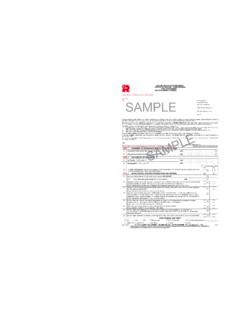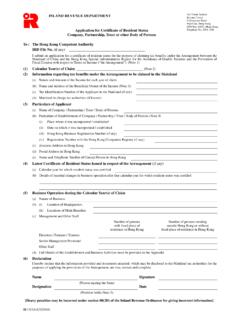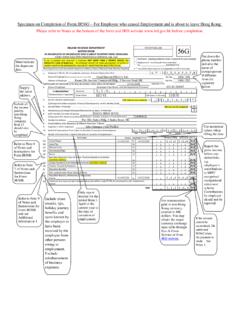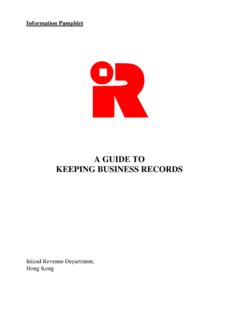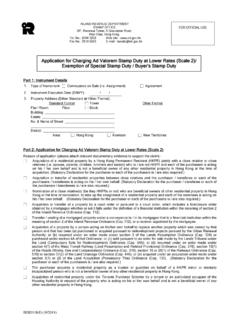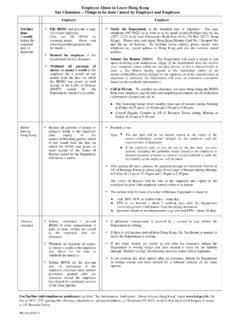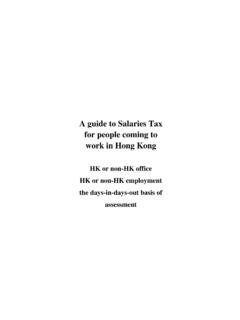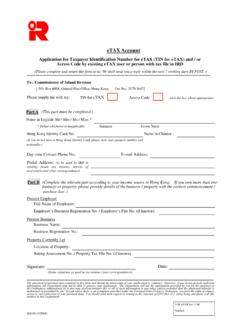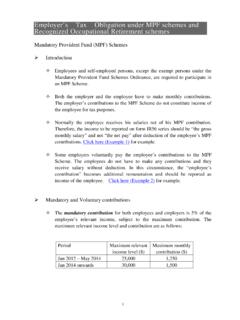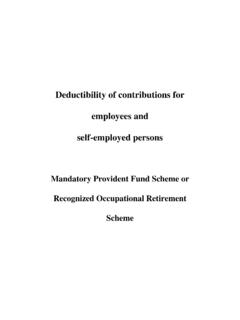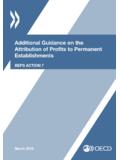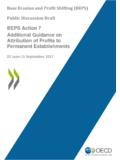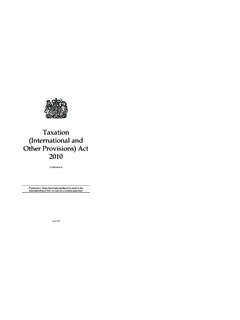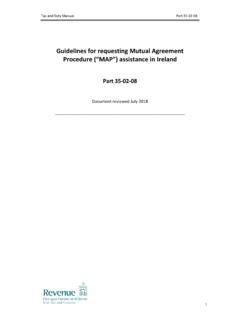Transcription of Departmental Interpretation And Practice Notes - No
1 Inland Revenue Department Hong Kong Departmental Interpretation AND Practice Notes NO. 46 TRANSFER PRICING GUIDELINES -METHODOLOGIES AND RELATED ISSUES These Notes are issued for the information of taxpayers and their tax representatives. They contain the Department s Interpretation and practices in relation to the law as it stood at the date of publication. Taxpayers are reminded that their right of objection against the assessment and their right of appeal to the Commissioner, the Board of Review or the Court are not affected by the application of these Notes . LAU MAK Yee-ming, Alice Commissioner of Inland Revenue December 2009 Our web site : Departmental Interpretation AND Practice Notes No. 46 CONTENTS Paragraph Introduction Defining the issue 1 Associated enterprises Associated enterprises article 9 Participation in management, control or capital 13 Elimination of double taxation Double taxation and appropriate adjustment 15 Statutory provisions and case laws Provisions and case laws relevant to transfer pricing 17 Permanent establishments Attribution rules and profits of a permanent establishment 29 Arm s length principle The arm s length principle 36 Applying the arm s length principle 39 Functional analysis 40 Comparability analysis 43 Determining comparability Factors identified by OECD 48 Characteristics of property or services 49 Functions.
2 Assets and risks 50 Contractual terms 53 Economic and marketing circumstances 54 Business strategies 55 Global price lists 61 Establishing the reliability of the data 63 Transfer pricing methodologies The methodologies 66 Source of profits Transfer pricing and source of profits or income 71 Tax schemes Abusive tax schemes 73 Transfer pricing schemes 76 Documentation Transfer pricing documentation 85 Intra-group service Service arrangement 90 Deduction of expenditure paid for intra-group service 95 Amount of intra-group service charge 100 Services provided by a permanent establishment 106 Conclusion Overall position 109 Appendix: Transfer pricing methodologies A Comparable uncontrolled price method B Cost plus method C Resale price method D Profit split method E Transactional net margin method ii INTRODUCTION Defining the issue Transfer pricing is concerned with prices charged between associated enterprises for the transfer of goods, services and intangible property.
3 Provisions relevant to transfer pricing can be found in the Inland Revenue Ordinance (the IRO) and the comprehensive double taxation agreements (the DTAs). By orders made by the Chief Executive in Council under section 49 of the IRO, the arrangements in the DTAs will have effect in relation to tax under the IRO notwithstanding anything in any enactment. 2. This Practice Note sets out the Department s views and practices on the methodologies of transfer pricing and related issues. Departmental Interpretation and Practice Notes No. 45 deals with double taxation relief of transfer pricing adjustments. 3. Hong Kong has so far concluded five DTAs with Belgium, Thailand, Mainland China, Luxembourg and Vietnam. They all have provisions mandating the adoption of the arm s length principle for pricing transactions between associated enterprises.
4 It is expected that future DTAs will contain similar provisions. 4. The arm s length principle uses the transactions of independent enterprises as a benchmark to determine how profits and expenses should be allocated for the transactions between associated enterprises. It compares what an enterprise has transacted with its associated enterprise with what a truly independent enterprise would have done in the same or similar circumstances. 5. If transfer pricing does not follow the arm s length principle, the tax liabilities of associated enterprises will be distorted. The basic rule for DTA purposes is that profits tax charged or payable should be adjusted, where necessary, to reflect the position which would have existed if the arm s length principle had been applied instead of the actual price transacted between the enterprises.
5 6. The arm s length principle which is endorsed by the Organisation for Economic Co-operation and Development (the OECD) is embodied in the Associated Enterprises Article or Article 9 of the OECD Model Tax Convention on Income and on Capital (the OECD Model). The DTAs of the Hong Kong SAR have adopted the article and the provisions for rewriting of transactions therein. 7. Under the Business Profits Article or Article 7 of the OECD Model, transfer pricing principles are equally applicable to transactions between different parts of an enterprise ( between a head office and permanent establishment or between different permanent establishments of the same enterprise). 8. Generally, the Commissioner would seek to apply the principles in the OECD Transfer Pricing Guidelines for Multinational Enterprises and Tax Administrations (the OECD Transfer Pricing Guidelines), except where they are incompatible with the express provisions of the IRO.
6 Transactions actually undertaken by the associated enterprises would be considered, except where the economic substance differs from its form or the structure is not one that commercially rational independent enterprises would arrange. The use of ranges, such as an inter-quartile range, would be accepted in the determination of an arm s length price. ASSOCIATED ENTERPRISES Associated enterprises article 9. The general application of the arm s length principle is articulated in the Associated Enterprises Article or Article 9 of the OECD Model. Article 9(1) states that: Where (a) an enterprise of a Contracting State participates directly or indirectly in the management, control or capital of an enterprise of the other Contracting State, or 2 (b)
7 The same persons participate directly or indirectly in the management, control or capital of an enterprise of a Contracting State and an enterprise of the other Contracting State, and in either case conditions are made or imposed between the two enterprises in their commercial or financial relations which differ from those which would be made between independent enterprises, then any profits which would, but for those conditions, have accrued to one of the enterprises, but, by reason of those conditions, have not so accrued, may be included in the profits of that enterprise and taxed accordingly. 10. This means that, pursuant to the Associated Enterprises Article of the DTAs, a DTA state has the right to adjust upwards the profits of an enterprise of that state: (a) if that enterprise participates in the management, control or capital of an enterprise of the other DTA state (the parent-subsidiary clause); or (b) the same persons participate directly or indirectly in the management, control or capital of that enterprise and an enterprise of the other DTA state (the common-control clause); and (c) the conditions in their relationship differ from the conditions which would have been stipulated between independent enterprises.
8 11. The OECD Transfer Pricing Guidelines explain how to decide and apply the most appropriate transfer pricing methodology. The existence of a DTA however is not a prerequisite for making transfer pricing adjustments. Where the circumstances warrant, adjustments will be made to transactions, domestic or otherwise, under the provisions of the IRO. 12. The Business Profits Article or Article 7 of the OECD Model also adopts the arm s length principle for transactions between a permanent 3 establishment of a DTA state and its head office or other related branches of the other DTA state. The DTAs of the Hong Kong SAR have incorporated the same article for the attribution of profits to a permanent establishment in Hong Kong, and the attribution should observe the arm s length principle.
9 This Practice Note therefore is also applicable to Article 7. Participation in management, control or capital 13. Under Article 9(1), two enterprises are associated enterprises with respect to each other if one of the enterprises meets the conditions of that Article. 14. The term associated enterprises has been given a very wide meaning without being expressed solely in terms of control but in terms of one enterprise participating directly or indirectly in the management, control or capital of an enterprise of the other contracting state or the same persons participating in both enterprises. It is important to note that no threshold is prescribed in the article. ELIMINATION OF DOUBLE TAXATION Double taxation and appropriate adjustment 15. Article 9(2) provides for a corresponding downward adjustment ( an appropriate adjustment) to profits to be made in the other DTA state where an upward adjustment has been made under Article 9(1).
10 This seeks to eliminate the double taxation that would otherwise arise. Article 9(2) of the OECD Model reads : Where a Contracting State includes in the profits of an enterprise of that State and taxes accordingly - profits on which an enterprise of the other Contracting State has been charged to tax in that other State and the profits so included are profits which would have accrued to the enterprise of the first-mentioned State if the conditions made between the two enterprises had been those which would have been made between independent enterprises, then that other State shall make an appropriate adjustment to the amount of the tax charged 4 therein on those profits. In determining such adjustment, due regard shall be had to the other provisions of this Convention and the competent authorities of the Contracting States shall if necessary consult each other.
